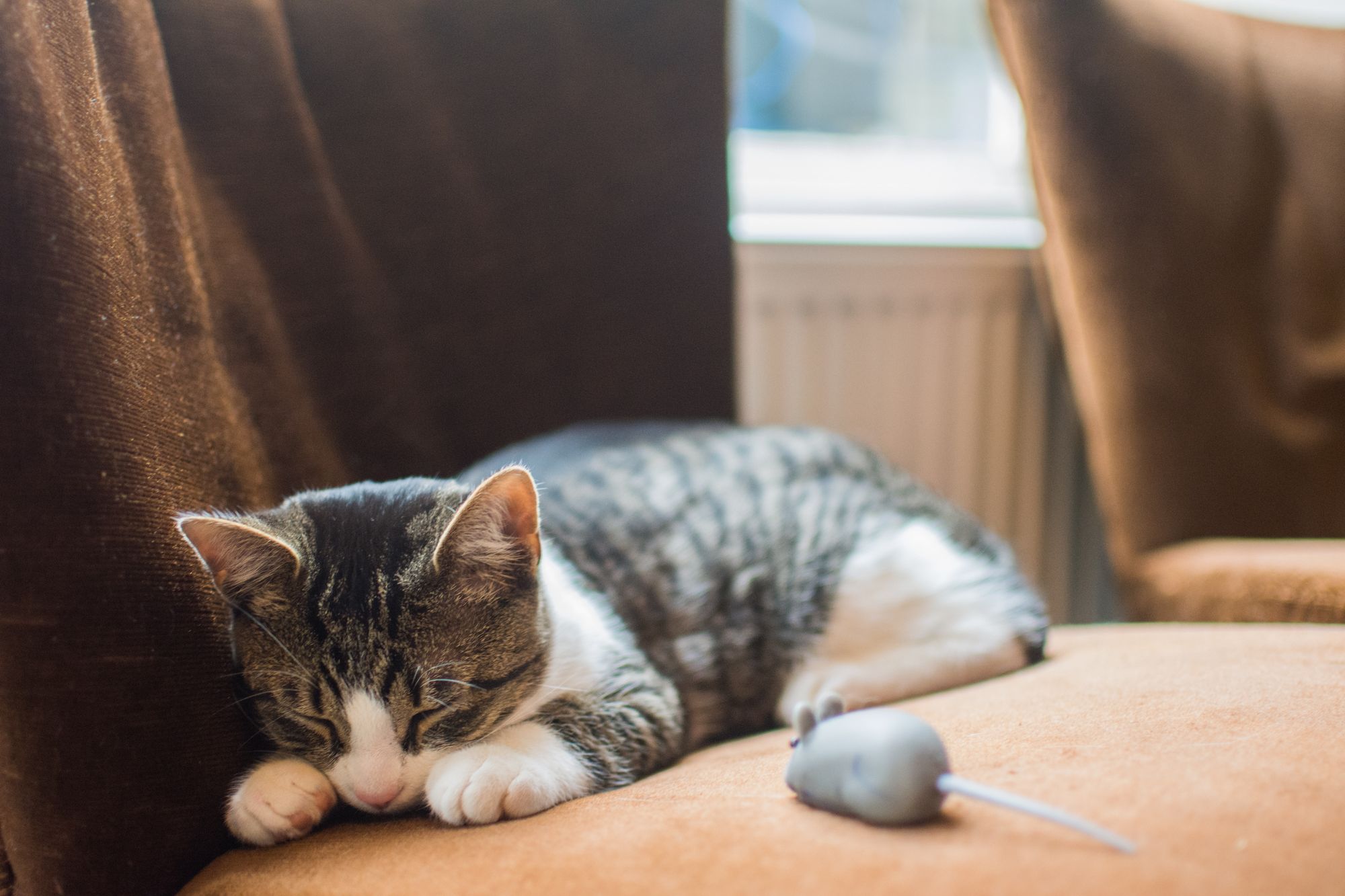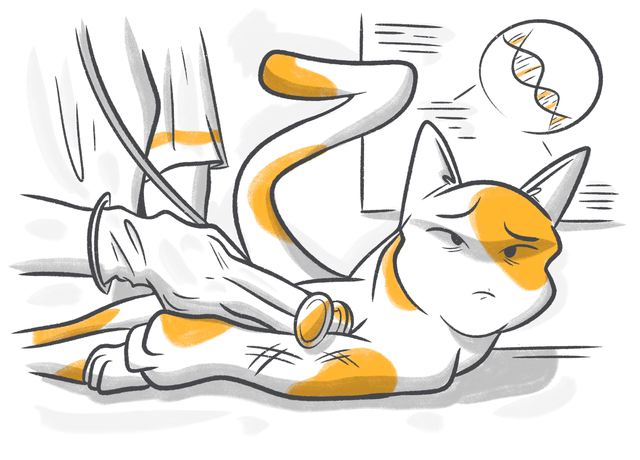Anemia is a blood disorder that isn’t a disease but a symptom of one or several underlying health conditions. It occurs when one’s red blood cell count goes below the normal range.
This drop may either be due to the following causes: a) a loss of blood; b) when the body destroys too many red blood cells (RBCs); or c) when there is a decrease in the production of RBCs. When it comes to cats, many possible health problems may result in a cat becoming anemic.
Stop Googling - Ask a Real Vet
Red blood cells deliver oxygen across the cells and tissues of a cat’s body. If a cat’s RBC count falls quickly and becomes dangerously low, they will show symptoms of a lack of oxygen, such as breathing difficulties, pale gums, an increased heart rate, and lethargy.
When a cat has anemia, there aren’t enough RBCs circulating in their blood, or there may be a lack of hemoglobin within their RBCs. A type of protein, hemoglobin is a component of red blood cells that serves as a binder of oxygen as it makes its way throughout the cat’s cells and tissues.
According to Cornell Feline Health Center study, while the prognosis of cat anemia depends on the underlying health issue involved, some cats can recover well after treatment and live happy life moving forward.
Content:
- Types of Cat Anemia
- Causes of Anemia in Cats
- Signs of Anemia in Cats
- Flea Anemia in Cats
- Treatment for Cats Suffering from Anemia
- How Can the Emergency Fund Help with Treatment
- FAQ
- Conclusion
Types of Cat Anemia
There are two broad types of anemia in cats:
-
Regenerative
Red blood cells become lost or are destroyed. With the decrease in RBC count, the bone marrow reacts by increasing the production of red blood cells. -
Non-regenerative
There is a suppression of red blood cell production. Here, the bone marrow doesn’t respond adequately to the body’s need for more red blood cells.
Read more: What Are The Symptoms Of Cat Diabetes?
Causes of Anemia in Cats
Cat anemia causes fall under the two categories mentioned above regenerative or non-regenerative.
Regenerative Anemia Causes
-
Blood Loss
External or internal blood loss may be due to trauma or a serious injury (getting hit by a vehicle), blood parasites, tumors, or ulcers in the stomach. -
Hemolysis
This is when the red blood cells are prematurely destroyed by the body due to immune-mediated hemolytic anemia. -
Infections
Viruses and bacteria may also cause anemia. These may include feline immunodeficiency virus (FIV), feline leukemia virus (FeLV), hermobartonella, and blood parasites. -
Toxins
Cats may accidentally ingest toxins, including certain medications, toxic plants, chemicals, and toxic food. -
Genetic Diseases
Somali and Abyssinian cat breeds are more prone to an enzyme deficiency that may result in a particular type of anemia.
Non-regenerative Anemia Causes
-
Chronic Disease
Liver, thyroid, and adrenal diseases, as well as certain types of cancer, may cause anemia in cats. Chronic diseases are the most common cause of anemia in animals. -
Poor Diet
A very poor diet or starvation may cause anemia in cats due to a nutrition deficiency. -
Kidney Disease
With kidney disease, the kidneys produce less erythropoietin (a hormone that aids in the production of new RBCs), which is also a common cause of cat anemia. 65% of felines with severe kidney disease become anemic.
Disorders of the Bone Marrow
Because the bone marrow generates both new red and white blood cells, any illness that affects the bone marrow may lead to anemia.
Signs of Anemia in Cats
The signs would depend on the underlying health condition, but below are some general signs to look out for. Two of the most common symptoms of anemia in cats are pale gums and lethargy.
Signs & Symptoms
- Lethargy;
- Pale gums;
- Increased heart rate;
- General weakness;
- Lack of appetite;
- Breathing difficulties;
- Water intake increases;
- Low blood pressure;
- Collapse.
Having a reliable pet camera such as the Petcube Camera goes a long way toward being able to monitor your pet 24/7 and detect symptoms of anemia or anything that seems amiss. Addressing health issues early on often leads to a better prognosis.
Flea Anemia in Cats
It’s hard to believe that a tiny flea can be life-threatening, but fleas come with risks. While it’s a given that fleas can cause itchiness and skin inflammation in pets, when too much blood is sucked by fleas, it can also lead to anemia.
Cats that are more susceptible to anemia due to fleas are:
- Kittens who live outdoors or are fed by a mother cat that goes outdoors;
- Senior cats that go outdoors.
Flea anemia symptoms in cats may include pale gums, listlessness, or a cold.
Treatment for Cats Suffering from Anemia

Depending on the underlying disease, treating anemia in cats may involve medications such as corticosteroids and dewormers. In some cases, surgery may be needed. Meanwhile, if your cat’s anemia has become severe, they may need a blood transfusion. This is done to stabilize your pet while determining the underlying cause before other treatments are given.
Depending on your vet’s diagnosis, the treatment will depend on your cat’s specific needs. As soon as you notice signs of anemia in your cat, it is important to bring them to the vet immediately for diagnosis and treatment since anemia can be life-threatening.
How Can the Emergency Fund Help with Treatment
It is important to be prepared for any pet emergency, and one wise way to be prepared is to be assured with a pet fund such as Petcube’s Pet Emergency Fund.
Because cat anemia can be life-threatening and must be addressed as soon as it is detected, having a Pet Emergency Fund subscription helps you take care of the vet bills right when you need them.
You also get access to their Online Vet service, where you can consult with certified veterinarians anytime and anywhere. This enables you to provide better care for your cat without having to worry about the bills needed for treatment.
FAQ
What is the recommended cat food for anemia?
Generally, a feline anemia diet that’s high in iron is recommended. Iron-rich foods such as lean meat, fish, and eggs. Iron supplements may also help. Note that choosing the right diet for your anemic cat would also depend on the underlying cause of their anemia. Consult with your vet first before introducing new food or supplements to your cat.
Is anemia in cats with kidney failure life-threatening?
A common complication of chronic kidney disease is anemia, which may cause the disease to progress further and can be life-threatening. In such cases, your vet may treat the anemia with darbepoetin to help them survive and have a better quality of life.
Conclusion
As with other health issues, if cat anemia is diagnosed early and your cat is generally healthy, the prognosis is good. On the other hand, when the anemia is due to autoimmune diseases, cancer, toxins, or severe trauma, it may not look good. However, it depends on your cat’s specific case. Thus, if you notice any symptoms of anemia in your cat, bring them to the vet immediately for diagnosis and treatment.
Was this article helpful?
Help us make our articles even better









